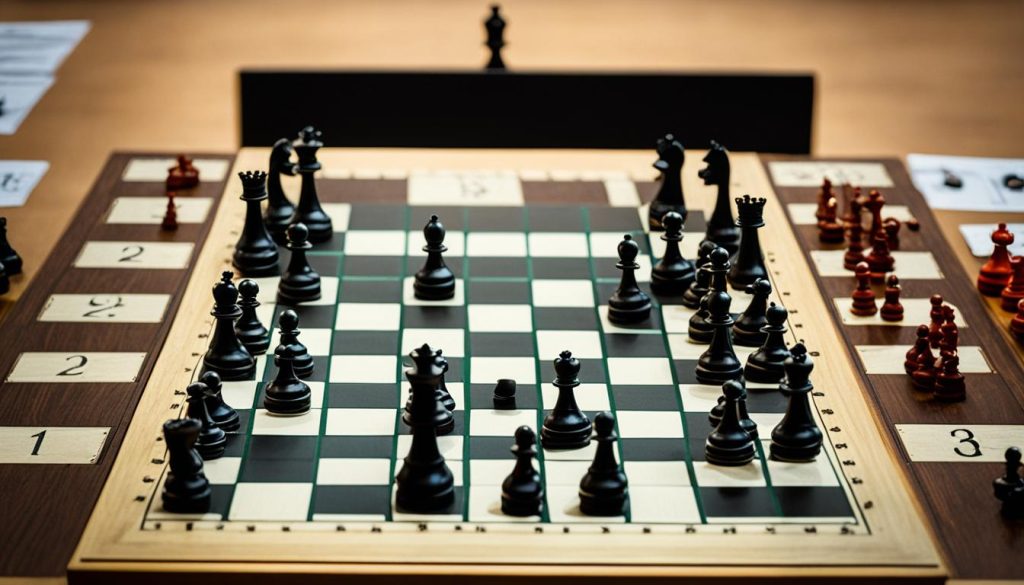Welcome to our guide on the Catalan Opening, a popular and strategic chess opening. Whether you’re a beginner or an experienced player, understanding the Catalan Opening theory and learning the best Catalan Opening variations can greatly enhance your gameplay and increase your chances of victory.
The Catalan Opening is a 1.d4 opening that combines the kingside fianchetto with pawns on d4 and c4. This opening aims for long-term positional pressure in the center and on Black’s queenside, leading to small and nagging advantages with technical endgames. The typical starting moves are 1.d4 Nf6 2.c4 e6 3.g3, but there are other possible move orders.
When facing the Catalan, Black has three main ways to respond. The first is playing …dxc4, known as the Open Catalan variation, which opens the diagonal for White’s g2-bishop. The second is reinforcing the d5-pawn with …c6, known as the Closed Catalan variation, resulting in a slow and maneuvering middlegame. Lastly, Black can avoid the Catalan altogether by delaying or avoiding …d5 and opting for an early …c5 instead.
Throughout history, the Catalan Opening has been played by renowned chess players, including world champions like Jose Raul Capablanca, Alexander Alekhine, and Mikhail Botvinnik. It gained significant popularity in the 1980s after being employed by Garry Kasparov and Viktor Korchnoi in their Candidates Semifinal match. Today, players like Magnus Carlsen, Vladimir Kramnik, and Anish Giri continue to utilize the Catalan Opening as a powerful tool in their repertoire.
In this informative series, we will delve deeper into the starting position and pros/cons of the Catalan Opening, explore its various variations, and uncover the rich history and popularity of this strategic chess opening. Stay tuned for insights from top grandmasters and learn how to play the Catalan Opening like a champion!
Starting Position of Catalan Opening
The Catalan Opening usually begins with the moves 1.d4 Nf6 2.c4 e6 3.g3, although other move orders are possible. The main idea is for White to fianchetto the kingside bishop after playing d4 and c4, while Black plays …e6. This opening gives White the opportunity to build positional pressure on Black’s queenside while keeping the king safe on the kingside. However, the c4 pawn can be vulnerable, and winning with small advantages requires advanced technical abilities.
One of the pros of the Catalan Opening’s starting position is the ability for White to develop their pieces harmoniously. By fianchettoing the kingside bishop, White gains control of key central squares and prepares for a potential attack on Black’s queenside.
Furthermore, the Catalan Opening allows White to avoid certain popular defenses like the Nimzo-Indian or King’s Indian Defense. This can surprise opponents who may be unprepared for the specific strategies and pawn structures that arise from the Catalan.
On the other hand, the c4 pawn in the Catalan Opening starting position can be a potential weakness. Black can target it by playing moves like …d5 or …b5, attempting to undermine White’s central control. It requires careful handling from White to defend this pawn and maintain their positional advantages.
Moreover, winning with small advantages in the Catalan Opening starting position often requires advanced technical abilities. The positional pressure created by White can be subtle and incremental, requiring precise calculation and strategic maneuvering to convert into a tangible advantage.
Pros:
- Harmonious piece development
- Surprising opponents
Cons:
- Vulnerable c4 pawn
- Requires advanced technical abilities to convert small advantages
Having a clear understanding of the starting position and the pros and cons of the Catalan Opening is crucial for successfully implementing this strategic opening in chess games.
Variations – Open Catalan and Closed Catalan
In the Catalan Opening, there are two main variations that players can choose from: the Open Catalan and the Closed Catalan. Each variation offers a different approach and strategic objectives.
Open Catalan
In the Open Catalan variation, Black chooses to open the diagonal for White’s g2-bishop by playing …dxc4. This move allows White to potentially regain the pawn, but it often leads to positional gambits and puts pressure on Black along the h1-a8 diagonal. The Open Catalan variation requires precise play from both sides and offers interesting complications on the board.
If you’re a player who enjoys dynamic positions and tactical challenges, the Open Catalan might be the variation for you. It allows for exciting middlegame play with strategic opportunities to exploit the weaknesses in your opponent’s position.
Closed Catalan
The Closed Catalan is the alternative variation where Black chooses not to capture on c4 with …dxc4. Instead, Black reinforces the d5-pawn with …c6. This leads to a slower and more maneuvering middlegame. The Closed Catalan is often characterized by a solid pawn structure and a focus on positional play.
If you prefer a more patient and strategic approach to chess, the Closed Catalan can be a great choice. It allows you to build a solid position, carefully maneuver your pieces, and create long-term plans to exploit weaknesses in your opponent’s position.
In addition to the Open and Closed variations, there are also Anti-Catalan variations where Black can avoid the Catalan Opening with early alternative moves. These variations can lead to different types of positions and strategic ideas, providing players with even more options and opportunities to explore.
Whether you prefer the dynamic and tactical nature of the Open Catalan or the solid and strategic approach of the Closed Catalan, mastering these variations in the Catalan Opening will enhance your understanding of chess strategy and make you a more versatile player.

History and Popularity of the Catalan Opening
The Catalan Opening is a prominent chess opening with a rich history and a loyal following among players. It is named after the 1929 Barcelona tournament where GM Savielly Tartakower is believed to have introduced it. However, records suggest that the opening was already in use as early as 1909, showcasing its longevity and enduring appeal in the chess world.
Throughout history, the Catalan Opening has been embraced by top players, including esteemed world champions like Jose Raul Capablanca, Alexander Alekhine, and Mikhail Botvinnik. These renowned chess masters recognized the strategic potential and unique characteristics of the Catalan Opening, making it an integral part of their repertoire.
In the 1980s, the Catalan Opening gained increased attention when legendary players Garry Kasparov and Viktor Korchnoi employed it in their Candidates Semifinal match. Their success further popularized the opening, prompting players of all levels to explore and adopt the Catalan as an essential weapon in their games.
Since then, the Catalan Opening has been employed by a plethora of famous players, showcasing its enduring relevance and ability to adapt to modern chess trends. Champions like Magnus Carlsen, Vladimir Kramnik, and Anish Giri have all demonstrated their prowess with this opening, solidifying its position as a powerful and respected choice in contemporary chess strategy.
Notable Players of the Catalan Opening:
- Garry Kasparov
- Viktor Korchnoi
- Magnus Carlsen
- Vladimir Kramnik
- Anish Giri

Conclusion
The Catalan Opening is a chess strategy that offers a wealth of grandmaster insights. It combines positional and tactical ideas, making it a powerful tool in a player’s repertoire. To fully utilize the advantages of the Catalan Opening, a strong understanding of chess strategy and tactics is crucial.
This opening is particularly effective against weaker opponents and players who prefer patient, maneuvering chess. It allows the player to apply continuous pressure and create small advantages that can be converted into winning positions. However, it may not be suitable for players seeking quick-strike games or those uncomfortable with exchanging major pieces early on.
Overall, the Catalan Opening is an excellent choice for players who appreciate strategic play and are willing to invest time in understanding its intricacies. Its popularity among top grandmasters, such as Jose Raul Capablanca, Alexander Alekhine, and Garry Kasparov, is a testament to its value in competitive play.






